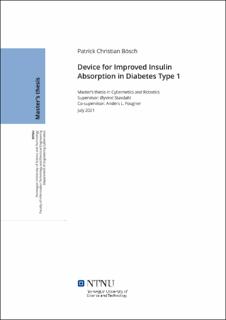Device for Improved Insulin Absorption in Diabetes Type 1
| dc.contributor.advisor | Stavdahl, Øyvind | |
| dc.contributor.advisor | Fougner, Anders L. | |
| dc.contributor.author | Bösch, Patrick Christian | |
| dc.date.accessioned | 2022-02-12T18:19:46Z | |
| dc.date.available | 2022-02-12T18:19:46Z | |
| dc.date.issued | 2021 | |
| dc.identifier | no.ntnu:inspera:76427839:27909927 | |
| dc.identifier.uri | https://hdl.handle.net/11250/2978566 | |
| dc.description.abstract | Det har skjedd store forbedringer i behandling av Diabetes Mellitus gjennom de siste årene. Behandlingen har blitt mye mer kompleks og avansert og kommer seg langsomt men sikkert i nærheten av en kunstig bukspyttkjertel, som er "den hellige gral" i diabetes behandling. Men dessverre står den trege subkutane insulin administrasjon i veien ditt. Det finnes mange måter som er mistenkt å forbedre subkutan insulin absorpsjon. Lysterapi er en av disse og etter den fikk lovende resultater fra en små pilotstudie bestemte den Kunstig Bukspyttkjertel Trondheim (APT) Gruppe seg å undersøke dette teknologi videre. Under pilotstudie ble det oppdaget at de kommersielle lysterapi systemer er ikke særlig egnet til forskning. Det er hovedsaklig på grunn av manglende modularitet og tilpasningsevne. APT bestemte seg derfor å bygge sitt eget lysterapi system som er tilpasset til de planlagte videregående forsøk. Det ble bestemt å legge utviklingsarbeid og prototype bygging ut som studentoppgave. På grunn av oppgavenstørrelse ble den delt opp i en prosjekt- og en masteroppgave. Dette masteroppgave er derfor en direkt fortsettelse av prosjektoppgaven. Den handler hovedsaklig om avslutting av konseptfase og å finne løsninger til de følgende tre deloppgaver: den optimale lyskildeplassering, et tilfredstillende kjølingopplegg og utforming av protypens elektronikk som er alle sammen del av utformingsfasen. Til slutten presenteres det også veien viddere i prototypenutviklingsprosessen. | |
| dc.description.abstract | Over the past decades, Diabetes Mellitus management has advanced dramatically, becoming increasingly complex and refined in order to approach the "Holy Grail" of diabetes management, the Artificial Pancreas. However, the slow dynamics of subcutaneous (SC) insulin have proven to be a significant barrier, and numerous ways are being researched to overcome or mitigate this problem. One of those techniques to reduce the impact of sluggish SC insulin dynamics is being investigated by the Artificial Pancreas Trondheim (APT) Group. Based on the results of a pilot study they previously conducted, they plan to investigate the vasodilating properties of NIR radiation further, as enhanced subcutaneous blood flow would drastically minimise the adsorption delay of SC insulin. When analysing the data from the pilot trial, it was discovered that the commercially available Light-Therapy devices are hard to use and provide only limited functionality. As a result, it was decided to develop and build a Light-Therapy device specifically tailored to the intended future studies that are planned in order to confirm the findings of the pilot study. The project development of such a device is rather complex and time intensive. It was therefore decided to split the task into a Project and a Master thesis. This Master thesis is building upon the ground works laid by the Project thesis and is a direct continuation of it. The thesis concludes the Concept Phase of the product development process and solves the challenges of optimal LED placement, appropriate LED cooling and design of the control electronics from the Design Phase. In the end of this thesis, it provides a detailed outlook of the next steps in the product development process. | |
| dc.language | eng | |
| dc.publisher | NTNU | |
| dc.title | Device for Improved Insulin Absorption in Diabetes Type 1 | |
| dc.type | Master thesis |
